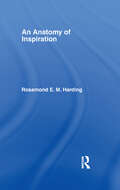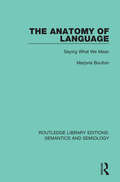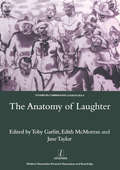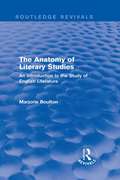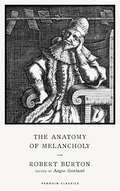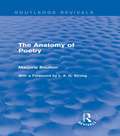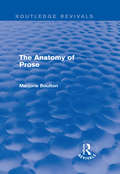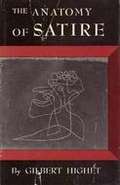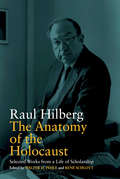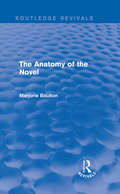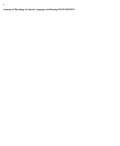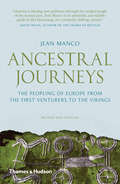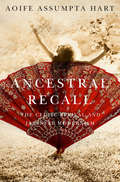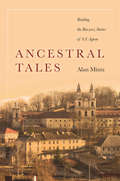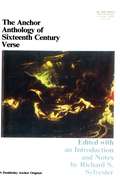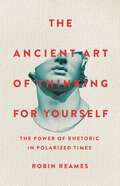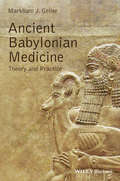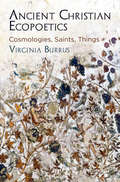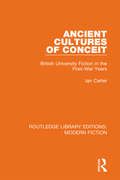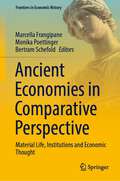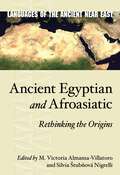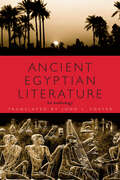- Table View
- List View
Anatomy of Inspiration
by Rosamond E HardingFirst Published in 1967. This volume is a collection of works, like letters, autobiographies and eye-witness accounts, relating to historical data that exits relating to 'mind in creation'. It includes an appendix with 'The Birth of a Poem' by Robert B.M. Nichols.
The Anatomy of Language: Saying What We Mean (Routledge Library Editions: Semantics and Semiology #2)
by Marjorie BoultonFirst published in 1959, this book aims to provide a practical introduction to semantics, relating the critical study of language to real-life situation, with a wealth of anecdotes and numerous illustrations drawn from everyday personal predicaments. This book provides much information and much material for profitable discussion, helping to make accessible what can be a highly academic subject comprehensible only to a minority. This book provides a highly valuable foundation for students of linguistics and will provide preparation for further study.
The Anatomy of Laughter
by Toby Garfitt"The nature of laughter has recently attracted the attention of a number of different disciplines. In two recent colloquia, TRIO (Translation Research in Oxford) brought together international authorities from fields as diverse as physiology, psychology, linguistics, translation and literary studies, and sociology, with scant regard for political correctness. This fascinating and often hilarious collection of essays is the result. With the contributions: Jane Taylor - Introduction Dominique Bertrand - Anatomie et etymologie: ordre et desordre du rire selon Laurent Joubert Silke Kipper, Dietmar Todt - The Sound of Laughter: Recent Concepts and Findings in Research into Laughter Vocalizations Sarah-Jayne Blakemore - Why Can't You Tickle Yourself? Michael Holland - Belly Laughs Walter Redfern - Upping the Ante/i: Exaggeration in Celine and Valles Giselinde Kuipers - Humour Styles and Class Cultures: Highbrow Humour and Lowbrow Humour in the Netherlands Christie Davies - Searching for Jokes: Language, Translation, and the Cross-Cultural Comparison of Humour Ted Cohen - And What If They Don't Laugh? Iain Galbraith - Without the Rape the Talk-Show Would Not Be Laughable Jean-Michel Deprats - Translating a Great Feast of Languages Paul J. Memmi - Traduire le rire Natacha Thiery - Rire et desir dans les comedies americaines de Lubitsch: l'exemple de Ninotchka (1939) Adam Phillips - What's So Funny? On Being Laughed at ...Sukanta Chaudhuri - Laughing and Talking Georges Roque - Le Rire comme accident en peinture Laurent Bazin - La Couleur du rire: peinture et traduction Gerard Toulouse - Views on the Physics and Metaphysics of Laughter"
The Anatomy of Literary Studies: An Introduction to the Study of English Literature (Routledge Revivals)
by Marjorie BoultonFirst published in 1980, The Anatomy of Literary Studies provides students of English Literature with a clearer understanding of the significance and scope of the subject and a comprehensive background to its study. It gives pointers towards intellectual integrity and advice on independent study, libraries, essay writing and examinations. This reissue of Marjorie Boulton’s classic work will be of particular value to students studying English at university or those applying to a course who would like a fuller understanding of what it might entail.
The Anatomy of Melancholy
by Robert BurtonCelebrating the 400th anniversary of Burton's masterpiece, this fully edited, modern edition is published as a landmark hardback volume in Penguin Classics. Robert Burton's labyrinthine, beguiling, playful masterpiece is his attempt to 'anatomize and cut up' every aspect of the condition of melancholy, from which he had suffered throughout his life. Ranging over beauty, digestion, the planets, alcohol, demons, kissing, poetry and the restorative power of books, among many other things, The Anatomy of Melancholy has fascinated figures from Samuel Johnson to Jorge Luis Borges since the seventeenth century, and remains an incomparable examination of the human condition in all its flawed, endless variety.
The Anatomy of National Fantasy: Hawthorne, Utopia, and Everyday Life
by Lauren Gail BerlantCareful appraisal of The Scarlet Letter.
The Anatomy of Poetry (Routledge Revivals)
by Marjorie BoultonIt is impossible to appreciate poetry fully without some knowledge of the various aspects of poetic technique. First published in 1953, with a second edition in 1982, this title explains all the usual technical terms in an accessible manner. Marjorie Boulton shows that it is possible to approach a poem from a business-like perspective without losing enjoyment. This reissue will be of particular value to students as well as those with a general interest in the specifics of poetry.
The Anatomy of Prose (Routledge Revivals)
by Marjorie BoultonFirst published in 1954, this title is a companion to The Anatomy of Poetry as a literary guide for the student reader. Writing that students generally find it more challenging to analyse a passage of prose than a piece of poetry, Marjorie Boulton takes a systematic approach to the technical elements of prose, considering form, vocabulary, rhythm and the application of historical context. With suggestions for further reading and practical, lucid advice, this reissue will be of particular value to students of English Literature in need of a constructive study aid.
Anatomy of Satire (Princeton Legacy Library)
by Gilbert HighetLiterary satire assumes three main forms: monologue, parody, and narrative (some fictional, some dramatic). This book by Gilbert Highet is a study of these forms, their meaning, their variation, their powers. Its scope is the range of satirical literature―from ancient Greece to modern America, from Aristophanes to Ionesco, from the parodists of Homer to the parodists of Eisenhower. It shows how satire originated in Greece and Rome, what its initial purposes and methods were, and how it revived in the Renaissance, to continue into our own era.
The Anatomy of the Holocaust: Selected Works from a Life of Scholarship (Vermont Studies on Nazi Germany and the Holocaust #8)
by Raul Hilberg Walter H. Pehle René SchlottThough best known as the author of the landmark 1961 work The Destruction of the European Jews, the historian Raul Hilberg produced a variety of archival research, personal essays, and other works over a career that spanned half a century. The Anatomy of the Holocaust collects some of Hilberg’s most essential and groundbreaking writings—many of them published in obscure journals or otherwise inaccessible to nonspecialists—in a single volume. Supplemented with commentary and notes from Hilberg’s longtime German editor and his biographer, it not only offers a multifaceted look at the man and the scholar, but also traces the evolution of Holocaust research from a marginal subdiscipline into a diverse and vital intellectual project.
The Anatomy of the Novel (Routledge Revivals)
by Marjorie BoultonFirst published in 1975, this title provides an introduction to the study of the novel. Marjorie Boulton deals systematically with the major elements of plot, character, authorial conventions, narrative structure, and dialogue and distinguishes different types of fiction. The emphasis is on the mainstream novel, with examples and arguments illustrated by quotations from five classics. Of particular value to students of English Literature, this reissue aims to help the reader ‘not only to read novels more discerningly and to discuss them more profitably, but also to relish the reading more’.
Anatomy & Physiology for Speech, Language, and Hearing
by J. Anthony Seikel PhD David G. Drumright Bs Daniel J. Hudock Ccc-SlpNOTE: This book comes with supplementary content on a PluralPlus companion website. If you purchase or rent a used copy of the printed book, the code to access the website printed inside the book may have been previously redeemed/used or be incorrect and you will not be able to use it. To guarantee access to the website, it is recommended you purchase a new copy of this book. Anatomy & Physiology for Speech, Language, and Hearing, Sixth Edition provides a solid foundation in anatomical and physiological principles relevant to communication sciences and disorders. This bestselling textbook beloved by instructors and students integrates clinical information with everyday experiences to reveal how anatomy and physiology relate to the speech, language, and hearing systems. Combining comprehensive coverage with abundant, beautiful full-color illustrations and a strong practical focus, the text makes complex material approachable even for students with little or no background in anatomy and physiology. The text includes numerous full-color anatomical images to help students form a clear, accurate understanding of the classical framework of the speech, language, and hearing systems. Photographs provide a real-life look at the body parts and functions. Use these images as reference for accuracy in describing body systems, parts, and processes.
Ancestral Journeys: The Peopling of Europe from the First Venturers to the Vikings (Revised and Updated Edition)
by Jean Manco“An ambitious and lucid full narrative account of the peopling of Europe . . . this will undoubtedly provide a base line for future debates on the origins of the Europeans.” —J. P. Mallory, author of In Search of the Indo-Europeans and The Origins of the Irish Who are the Europeans? Where did they come from? New research in the fields of archaeology and linguistics, a revolution in the study of genetics, and cutting-edge analysis of ancient DNA are dramatically changing our picture of prehistory, leading us to question what we thought we knew about these ancient peoples. This paradigm-shifting book paints a spirited portrait of a restless people that challenges our established ways of looking at Europe’s past. The story is more complex than at first believed, with new evidence suggesting that the European gene pool was stirred vigorously multiple times. Genetic clues are also enhancing our understanding of European mobility in epochs with written records, including the arrival of the Anglo-Saxons, the spread of the Slavs, and the adventures of the Vikings. Now brought completely up to date with all the latest findings from the fast-moving fields of genetics, DNA, and dating, Jean Manco’s highly readable account weaves multiple strands of evidence into a startling new history of the continent, of interest to anyone who wants to truly understand Europeans’ place in the ancient world.
Ancestral Recall: The Celtic Revival and Japanese Modernism
by Aoife Assumpta HartDespite distance and differences in culture, the early twentieth century was a time of literary cross-pollination between Ireland and Japan. Notably, the Irish poet and playwright William Butler Yeats had a powerful influence on Japanese letters, at the same time that contemporary and classical Japanese literature and theatre impacted Yeats’s own literary experiments. Citing an extraordinary range of Japanese and Irish texts, Aoife Hart argues that Japanese translations of Irish Gaelic folklore and their subsequent reception back in Ireland created collisions, erasures, and confusions in the interpretations of literary works. Assessing the crucial roles of translation and transnationalism in cross-cultural exchanges between the Celtic Revival and Japanese writers of the modern period, Hart proves that interlingual dialogue and folklore have the power to reconstruct a culture’s sense of heritage. Rejecting the notion that the Celtic Revival was inward and parochial, Hart suggests that, seeking to protect their heritage from the forces of globalization, the Irish adapted their understanding of heritage to one that exists within the transnational contexts of modernity – a heritage that is locally produced but internationally circulated. In doing so, Hart maintains that the cultural contact and translation between the East and West traveled in more than one direction: it was a dialogue presenting modernity’s struggles with cosmopolitanism, gender, ethnic identity, and transnationalism. An inspired exploration of transpacific literary criticism, Yeats scholarship, and twentieth-century Japanese literature, Ancestral Recall tracks the interplay of complex ideas across languages and discourses.
Ancestral Recall: The Celtic Revival and Japanese Modernism
by Aoife Assumpta HartDespite distance and differences in culture, the early twentieth century was a time of literary cross-pollination between Ireland and Japan. Notably, the Irish poet and playwright William Butler Yeats had a powerful influence on Japanese letters, at the same time that contemporary and classical Japanese literature and theatre impacted Yeats’s own literary experiments. Citing an extraordinary range of Japanese and Irish texts, Aoife Hart argues that Japanese translations of Irish Gaelic folklore and their subsequent reception back in Ireland created collisions, erasures, and confusions in the interpretations of literary works. Assessing the crucial roles of translation and transnationalism in cross-cultural exchanges between the Celtic Revival and Japanese writers of the modern period, Hart proves that interlingual dialogue and folklore have the power to reconstruct a culture’s sense of heritage. Rejecting the notion that the Celtic Revival was inward and parochial, Hart suggests that, seeking to protect their heritage from the forces of globalization, the Irish adapted their understanding of heritage to one that exists within the transnational contexts of modernity – a heritage that is locally produced but internationally circulated. In doing so, Hart maintains that the cultural contact and translation between the East and West traveled in more than one direction: it was a dialogue presenting modernity’s struggles with cosmopolitanism, gender, ethnic identity, and transnationalism. An inspired exploration of transpacific literary criticism, Yeats scholarship, and twentieth-century Japanese literature, Ancestral Recall tracks the interplay of complex ideas across languages and discourses.
Ancestral Tales: Reading the Buczacz Stories of S.Y. Agnon
by Alan MintzWritten in pieces over the last fifteen years of his life and published posthumously, S. Y. Agnon's A City in Its Fullness is an ambitious, historically rich sequence of stories memorializing Buczacz, the city of his birth. This town in present-day Ukraine was once home to a vibrant Jewish population that was destroyed twice over—in the First World War and again in the Holocaust. Agnon's epic story cycle, however, focuses not on the particulars of destruction, but instead reimagines the daily lives of Buczacz's Jewish citizens, vividly preserving the vanished world of early modern Jewry. Ancestral Tales shows how this collection marks a critical juncture within the Agnon canon. Through close readings of the stories against a shifting historical backdrop, Alan Mintz presents a multilayered history of the town, along with insight into Agnon's fictional transformations. Mintz relates these narrative strategies to catastrophe literature from earlier periods of Jewish history, showing how Agnon's Buczacz is a literary achievement at once innovative in its form of remembrance and deeply rooted in Jewish tradition.
Ancestral Voice: Conversations with N. Scott Momaday
by Charles L. WoodardA collection of questions posed by Charles L. Woodard (designated as: clw) that are answered by N. Scott Momaday (designated as: momaday). From the introduction: "The conversations in this book occurred in 1986 and 1987. In 1986 we were in Tucson in May, in Aspen, Colorado, in August, and in Santa Fe in November. In Tucson we met in Momaday's office at the University of Arizona and in his home; in Aspen we talked in his quarters at the writers' conference at which he was featured; and in Santa Fe we conversed in hotel living rooms near the Plaza. In each case we discussed a variety of subjects, and the topical conversations in this book are combinations drawn from all of those discussions... The conversations are lightly edited, for grammatical consistency, and I have added some transitions. The task was not difficult, because Momaday's careful responses are often almost textually complete. He was not involved in the editing process, but he has reviewed the completed text to verify its factual particulars."
The Anchor Book of Sixteenth Century Verse
by Richard D. SylvesterThis comprehensive anthology contains selections from the work of twenty-five poets of the sixteenth century. Employing the original, rather than normalized, texts, the volume includes complete, non-excerpted poems by John Skelton, Philip Sidney and others. The selections - which include such works as 'The Steele Glass'. Richard S. Sylvester examines the evolution of English poetry through the century, tracing the development of the early Tudor poets through the eloquence of Surrey.
The Ancient Art of Thinking For Yourself: The Power of Rhetoric in Polarized Times
by Robin ReamesHow rhetoric—the art of persuasion—can help us navigate an age of misinformation, conspiracy theories, and political acrimony The discipline of rhetoric was the keystone of Western education for over two thousand years. Only recently has its perceived importance faded. In this book, renowned rhetorical scholar Robin Reames argues that, in today&’s polarized political climate, we should all care deeply about learning rhetoric. Drawing on examples ranging from the destructive ancient Greek demagogue Alcibiades to modern-day conspiracists like Alex Jones, Reames breaks down the major techniques of rhetoric, pulling back the curtain on how politicians, journalists, and &“journalists&” convince us to believe what we believe—and to talk, vote, and act accordingly. Understanding these techniques helps us avoid being manipulated by authority figures who don&’t have our best interests at heart. It also grants us rare insight into the values that shape our own beliefs. Learning rhetoric, Reames argues, doesn&’t teach us what to think but how to think—allowing us to understand our own and others&’ ideological commitments in a completely new way. Thoughtful, nuanced, and leavened with dry humor, The Ancient Art of Thinking for Yourself offers an antidote to our polarized, post-truth world.
Ancient Babylonian Medicine: Theory and Practice (Ancient Cultures #11)
by Markham J. GellerUtilizing a great variety of previously unknown cuneiform tablets, Ancient Babylonian Medicine: Theory and Practice examines the way medicine was practiced by various Babylonian professionals of the 2nd and 1st millennium B.C. Represents the first overview of Babylonian medicine utilizing cuneiform sources, including archives of court letters, medical recipes, and commentaries written by ancient scholars Attempts to reconcile the ways in which medicine and magic were related Assigns authorship to various types of medical literature that were previously considered anonymous Rejects the approach of other scholars that have attempted to apply modern diagnostic methods to ancient illnesses
Ancient Christian Ecopoetics: Cosmologies, Saints, Things (Divinations: Rereading Late Ancient Religion)
by Virginia BurrusIn our age of ecological crisis, what insights—if any—can we expect to find by looking to our past? Perhaps, suggests Virginia Burrus, early Christianity might yield usable insights. Turning aside from the familiar specter of Christianity's human-centered theology of dominion, Burrus directs our attention to aspects of ancient Christian thought and practice that remain strange and alien. Drawn to excess and transgression, in search of transformation, early Christians creatively reimagined the universe and the human, cultivating relationships with a wide range of other beings—animal, vegetable, and mineral; angelic and demonic; divine and earthly; large and small.In Ancient Christian Ecopoetics, Burrus facilitates a provocative encounter between early Christian theology and contemporary ecological thought. In the first section, she explores how the mysterious figure of khora, drawn from Plato's Timaeus, haunts Christian and Jewish accounts of a creation envisioned as varyingly monstrous, unstable, and unknowable. In the second section, she explores how hagiographical literature queers notions of nature and places the very category of the human into question, in part by foregrounding the saint's animality, in part by writing the saint into the landscape. The third section considers material objects, as small as portable relics and icons, as large as church and monastery complexes. Ancient Christians considered all of these animate beings, simultaneously powerful and vulnerable, protective and in need of protection, lovable and loving. Viewed through the shifting lenses of an ancient ecopoetics, Burrus demonstrates how humans both loomed large and shrank to invisibility, absorbed in the rapture of a strange and animate ecology.
Ancient Cultures of Conceit: British University Fiction in the Post-War Years (Routledge Library Editions: Modern Fiction)
by Ian CarterThe campus novel is one of the best loved forms of fiction in the post-war period. But what are its characteristic themes? What are its prejudices? And what does it take for granted? Originally published in 1990, this is the first study to connect literary, historical, and sociological aspects of modern British universities. It shows that the culture celebrated in British university fiction represents a particular view of humane education which has its origins in the values of Oxbridge. Threats are seen to come from the ‘redbrick’ and ‘new’ universities, from proletarians, scientists (including sociologists), women, and foreigners. This exhilarating book makes a nonsense of sociology’s reputation for turgid and plodding analysis. Sharp-witted, shrewd, and penetrating, it will be of interest to students of sociology, literature, and for the same wide audience that appears to have an insatiable appetite for stories about university life.
Ancient Economies in Comparative Perspective: Material Life, Institutions and Economic Thought (Frontiers in Economic History)
by Marcella Frangipane Monika Poettinger Bertram SchefoldThis book investigates the economic organization of ancient societies from a comparative perspective. By pursuing an interdisciplinary approach, including contributions by archaeologists, historians of antiquity, economic historians as well as historians of economic thought, it studies various aspects of ancient economies, such as the material living conditions including production technologies, etc.; economic institutions such as markets and coinage; as well as the economic thinking of the time. In the process, it also explores the comparability of economic thought, economic institutions and economic systems in ancient history. Focusing on the Ancient Near East as well as the Mediterranean, including Greece and Rome, this comparative perspective makes it possible to identify historical permanencies, but also diverse forms of social and political organization and cultural systems. These institutions are then evaluated in terms of their capacity to solve economic problems, such as the efficient use of resources or political stability. The first part of the book introduces readers to the methodological context of the comparative approach, including an evaluation of the related historiographical tradition. Subsequent parts discuss a range of development models, elements of economic thinking in ancient societies, the role of trade and globalization, and the use of monetary and financial instruments, as well as political aspects.
Ancient Egyptian and Afroasiatic: Rethinking the Origins (Languages of the Ancient Near East)
by M. Victoria Almansa-Villatoro and Silvia ŠtubŇovÁ NigrelliBy challenging assumptions regarding the proximity between Egyptian and Semitic Languages, Ancient Egyptian and Afroasiatic provides a fresh approach to the relationships and similarities between Ancient Egyptian, Semitic, and Afroasiatic languages. This in-depth analysis includes a re-examination of the methodologies deployed in historical linguistics and comparative grammar, a morphological study of Ancient Egyptian, and critical comparisons between Ancient Egyptian and Semitic, as well as careful considerations of environmental factors and archaeological evidence. These contributions offer a reassessment of the Afroasiatic phylum, which is based on the relations between Ancient Egyptian and the other Afroasiatic branches. This volume illustrates the advantages of viewing Ancient Egyptian in its African context.In addition to the editors, the contributors to this collection include Shiferaw Assefa, Michael Avina, Vit Bubenik, Leo Depuydt, Christopher Ehret, Zygmunt Frajzyngier, J. Lafayette Gaston, Tiffany Gleason, John Huehnergard, Andrew Kitchen, Elsa Oréal, Chelsea Sanker, Lameen Souag, Andréas Stauder, Deven N. Vyas, Aren Wilson-Wright, and Jean Winand.
Ancient Egyptian Literature: An Anthology
by John L. FosterA beautifully translated collection sampling all the major genres of ancient Egyptian literature.Poetry, stories, hymns, prayers, and wisdom texts found exquisite written expression in ancient Egypt while their literary counterparts were still being recited around hearth fires in ancient Greece and Israel. Yet, because of its very antiquity and the centuries during which the language was forgotten, ancient Egyptian literature is a newly discovered country for modern readers.This anthology offers an extensive sampling of all the major genres of ancient Egyptian literature. It includes all the texts from John Foster’s previous book Echoes of Egyptian Voices, along with selections from his Love Songs of the New Kingdom and Hymns, Prayers, and Songs: An Anthology of Ancient Egyptian Lyric Poetry, as well as previously unpublished translations of four longer and two short poems. Foster’s translations capture the poetical beauty of the Egyptian language and the spirit that impelled each piece’s composition, making these ancient masterworks sing for modern readers. An introduction to ancient Egyptian literature and its translation, as well as brief information about the authorship and date of each selection, completes the volume.“This exceptional sampling of one of the world’s most ancient literatures offers more than 40 hymns, stories, prayers, and songs revolving around religion, the Pharaohs, life, death, love, and more. . . . . Highly recommended for all literary collections, this is also of interest to comprehensive collections of Egyptology, Near Eastern history, world literature in translation, and religion.” —Library Journal“Older than the Buddha and the Bhagavad Gita, these poems constitute a truly ancient literature, and Foster’s rich and textured translations make genuine love poems and exhortations to the gods out of what, to most of us, are just pictures.” —Booklist
